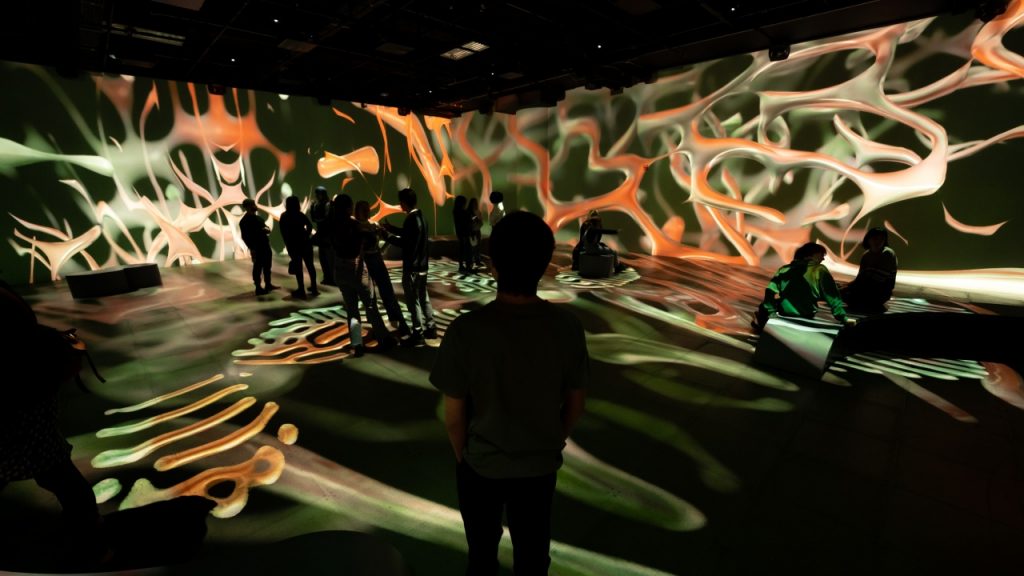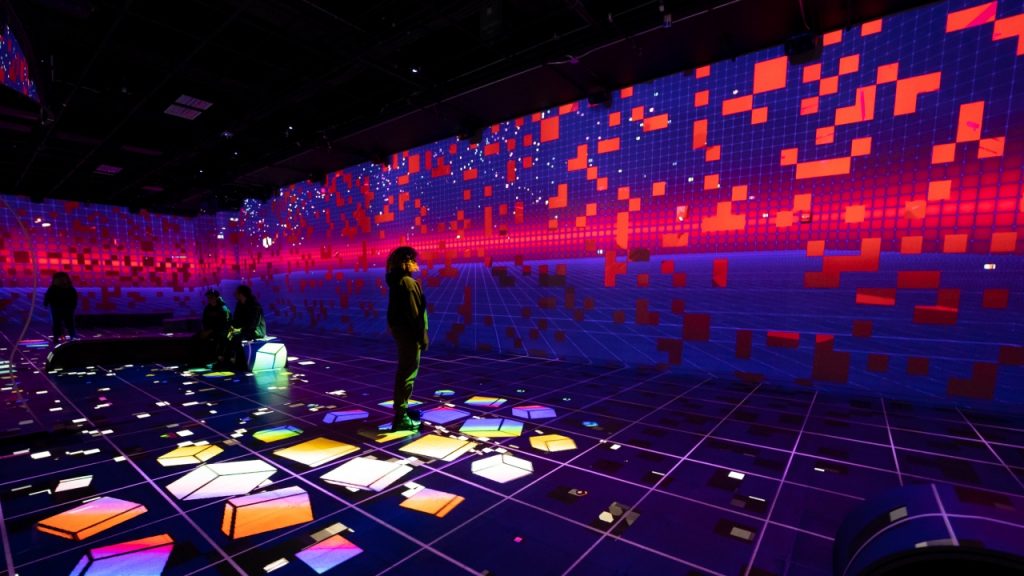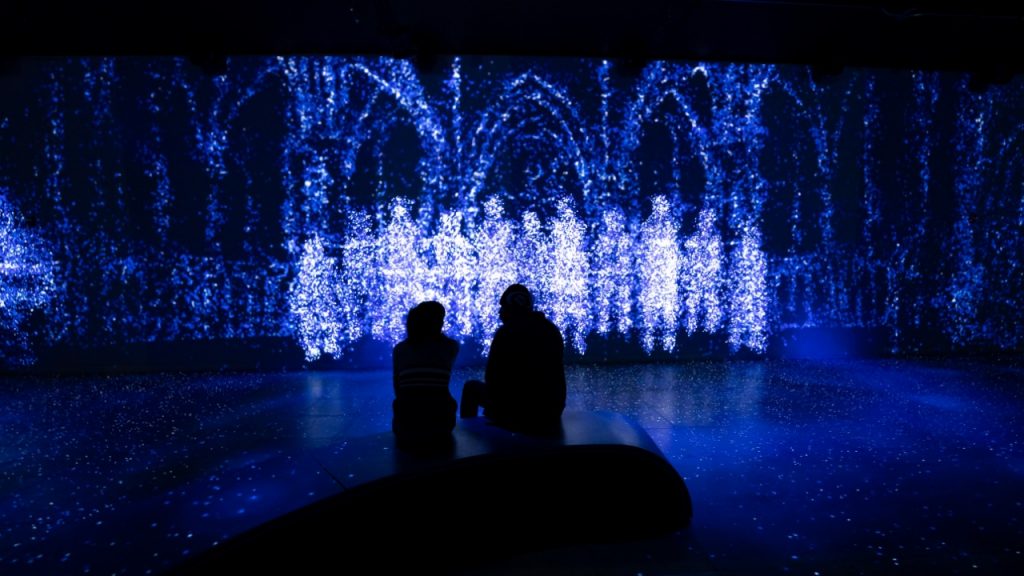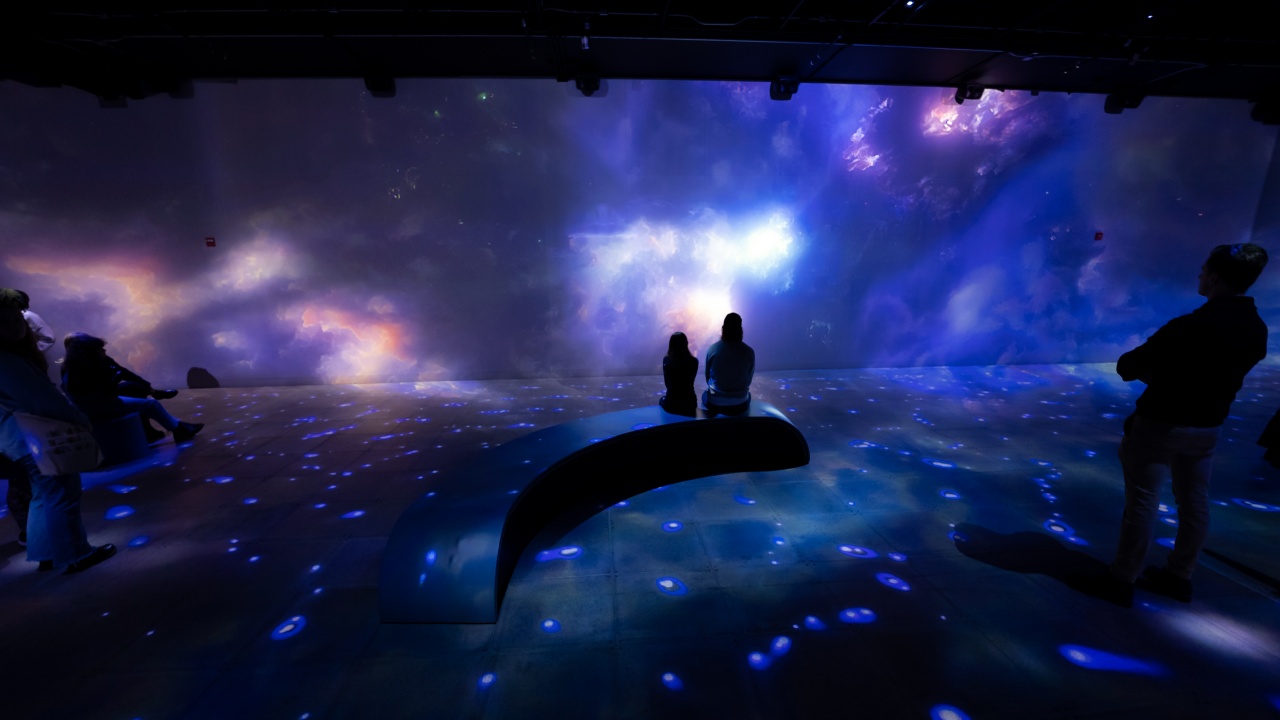transformé, this is a brand-new immersive show presented in by OASIS Immersion in Montreal. It’s goal: to offer “a fascinating voyage rooted in real-life stories from which emerges the infinite power of courage and empathy”.
More than a title, “transformation” is also the show’s central concept and ethos, both in terms of porting VR works to this new immersive format and transforming the audience by allowing them to discover touching, disturbing, and inspiring human-centred stories. (Press release)
Read the original French version by Xn Quebec here.

Celebrating Virtual Reality Stories by Transforming Them
The exhibit launched on January 19, 2023 includes eight works, arranged in three rooms organized thematically. The projects selected are:
- On the Morning you Wake (To the End of the World) (Mike Brett, Steve Jamison, Arnaud Colinart, and Pierre Zandrowicz, 2022)
- Vestige (Aaron Bradbury, 2018)
- Ferenj (Ainslee Alem Bobson, 2020)
- Tokyo Light Odyssey (Nakazi Takuma, Moriwaki Daisuke, and Kudo Kaoru, 2016)
- Container (Meghna Singh and Simon Wood, 2021)
- Goliath (Barry Gene Murphy and May Abdalla, 2021)
- Notes on Blindness (Arnaud Colinart, Amaury La Burthe, Peter Middleton, and James Spinney, 2016)
- Conscious Existence (Mark Zimmerman, 2019)
If some of these titles sound familiar, that’s because these were all originally virtual reality experiences. All have toured the festival circuit, and some have even received multiple awards. Be that as it may, not all of them have seen the widespread distribution they deserve.
One of transformé’s objectives is precisely to give another life to these projects.

To do this, these works had to be adapted—or even completely reconstructed—to make the most of this new “immersive” format. Gone are the head-mounted displays and their purely individual experience. In such interactive walkthrough exhibitions, collective and collaborative experiences are the norm. What challenges, limitations and affordances come up when shifting to this radically different apparatus?
Ruby-Maude Rioux (Senior Multimedia Conceptor, OASIS) tells me there was a strong interest within the team to tackle the challenge of adapting VR content: “We are all fans of immersion, new technologies, and new media in general”. Despite the technical challenges they faced, “the team was excited to be able to work on this kind of adaptation,” she adds.
Of course, the development process was not done by OASIS alone. Julie Castonguay (Executive Producer, OASIS) reminds us that “Developing transformé was the fruit of a unique collaboration involving our creative and technical teams and a group of talented virtual reality artists.”

Each work brought its own challenges (technical, aesthetic, but also narrative). It took collaboration with the original artists to adapt the projects—or even reinvent them in some cases. This was a process of translation and recreation, rather than a simple port of pre-existing content. “It was a painstaking process at the storytelling, technical and research levels through working with AI and creating the show’s soundscape. […] To a certain extent, this show is a tribute to their work and the transformative power of immersion,” Castonguay adds.
True Stories, Reinvented
At the technical and aesthetic level, transformé takes up a strong challenge. However, OASIS immersion also chose to tackle a narrative challenge. After RECHARGER/Unwind and Van Gogh – Distortion, both more contemplative and sensorial show, “we wanted to tell stories, but also to get closer to the human element,” says Ruby-Maude Rioux.
Starting from the power of empathy that is often associated with virtual reality, the exhibition focuses on stories that transport the audience into the worlds of diverse individuals. While some projects are as contemplative as what you might typically find in this sort of immersive gallery, others immerse us in more personal narratives. Those focus as much on grief (Vestige), anguish (On the Morning you Wake), and mental health (Goliath). These story-forward experiences are accompanied by musical compositions and voice-over narration that rival what films have to offer (Marion Cotillard and Emmanuel Schwartz lend their voices to the French-language versions of Vestige and Goliath respectively).

For a project like Notes on Blindness or even Goliath, virtual reality often seeks to foster empathy for a character by putting us in their head: we see the world from their point of view, which we control thanks to the VR headset. This is no longer possible with the immersive format. However, what transformé attempts with the new versions of these works, is to transport the audience into the world of the characters: to be with them and to immerse viewers in a space that reflects their perception of the world. “The development of the transformé project has been a fascinating exploration of our approach to storytelling and engaging our visitors in the awe-inspiring visual and audio canvas of OASIS immersion,” explains Jean-Pascal Comeau (Deputy Technical Director, Content and Experiences, OASIS)
Virtual reality is an intimate individual experience where the proximity of the subject allows a deep exploration of emotion. In contrast, on-site immersion offers a more contemplative—and sometimes even collaborative—collective experience.
Dominic St-Amant (Immersive Adaptation Consultant, Phosphen)
How is the process of fostering empathy for someone affected when the experience becomes collective?
New Experiences – Open Questions
The transformé exhibition sprang from a desire to explore the idea of converging individual- based virtual reality immersion with our own Oasis brand of collective immersion.
Denys Lavigne (President and Co-Founder, OASIS)
On the one hand, we must recognize the potential that this kind of immersive space represents in the distribution strategy of virtual reality experiences. Unlike distribution on VR headsets, such exhibits reduce some of the more painful technical constraints—an experience is not bound to a particular platform and does not need to be ported when a new headsets becomes the norm. Immersive spaces like OASIS Immersion also offer greater accessibility, whether in terms of age or (dis)ability.
All these advances make it possible to put immersive storytelling in reach for potentially larger and more diverse audiences. This is precisely one of the reasons motivating Antoine Cayrol (producer and co-founder, Atlas V), who represents several of the projects selected in transformé: “Bringing these works to large and diverse audiences has been my special mission in the nascent VR ecosystem.” The producer had shared this strategy with me when we spoke as part of the Crafting a market for independent XR study (Source).

On the other hand, only time will tell if the experiment will be a success: can we translate virtual reality works into an immersive exhibition format without sacrificing the experience’s original intentions? Does the translation process open new doors (aesthetic, narrative, experiential, etc.) that make up for the technical challenge of adapting these projects to a format for which they weren’t originally designed?
As Dominic St-Amant reminds us, the genre of immersive exhibitions “is still in its infancy, and we are all in a way pioneers writing the first sentences of a brand-new language.”



Leave a Reply
You must be logged in to post a comment.